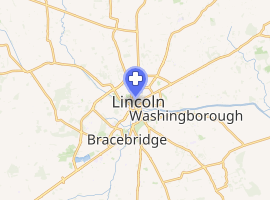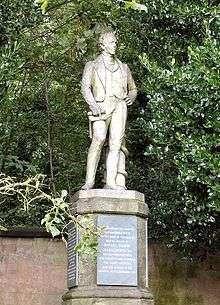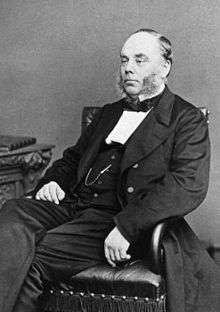The Lawn, Lincoln
The Lawn, Lincoln, Lincolnshire, England, is a notable early nineteenth century Greek revival building on Union Road, 0.3 miles (0.5 km) to the west of Lincoln Cathedral. The complex features a walled garden and children's play area.
| The Lawn | |
|---|---|
 The Lawn | |

| |
 Shown in Lincolnshire | |
| Geography | |
| Location | Lincoln, Lincolnshire, England |
| Coordinates | 53°14′06″N 0°32′38″W |
| Organisation | |
| Care system | National Health Service |
| Funding | Public hospital |
| Type | Mental health |
| History | |
| Opened | 1817 |
| Closed | 1985 |
| Links | |
| Website | www |
History

The hospital's origins lie in a bequest by Dr Paul Parnell to establish an asylum in Lincoln.[1] After delay caused by indecision by the management of the asylum, the project went ahead in 1817, and a facility designed by Richard Ingleman in the Greek revival style opened as the Lincoln Lunatic Asylum in April 1820.[2]
It was at the asylum that, in the 1830s, Robert Gardiner Hill, with the support of Edward Parker Charlesworth, pioneered a mode of treatment that suited "all types" of patients, so that mechanical restraints and coercion could be dispensed with—a situation he finally achieved in 1838. In 1839 Sergeant John Adams and Dr. John Conolly were impressed by the work of Hill, and introduced the method into their Hanwell Asylum, by then the largest in the country. Hill's system was adapted, since Conolly was unable to supervise each attendant as closely as Hill had done. By September 1839, mechanical restraint was no longer required for any patient.[3][4]
The facility became known as the Lincoln Lunatic Hospital in 1905 and The Lawn Hospital in 1921.[5] Mary Barkas, a respected psychiatrist, worked as Medical Superintendent at the hospital between 1928 and 1933.[6] The hospital joined the National Health Service in 1948 and, following the introduction of Care in the Community, closed in 1985.[7]
City of Lincoln Council acquired the hospital and operated it as an events venue until August 2016 when it sold it to R. W. Stokes & Sons who have redeveloped the property as a new business headquarters, cafe, restaurant and theatre.[8] A tropical glasshouse, the Sir Joseph Banks Conservatory, was moved from the site in late 2016.[9]
See also
References
| Wikimedia Commons has media related to The Lawn, Lincoln. |
- Roberts, Andrew. "Index of English and Welsh Lunatic Asylums and Mental Hospitals Based on a comprehensive survey in 1844, and extended to other asylums". A Middlesex University resource by Andrew Roberts. Middlesex University. Retrieved 19 January 2012.
- Leonard Smith (11 May 1999). Cure, Comfort and Safe Custody: Public Lunatic Asylums in Early Nineteenth-Century England. Continuum. p. 31. ISBN 978-0-567-24041-5.
- Suzuki, Akihto (January 1995). "The politics and ideology of non-restraint: the case of the Hanwell Asylum". Medical History. 183 Euston Road, London NWI 2BE.: Wellcome Institute. 39 (1): 1–17. doi:10.1017/s0025727300059457. PMC 1036935. PMID 7877402.CS1 maint: location (link)
- Edited by: Bynum, W. F; Porter, Roy; Shepherd, Michael (1988) The Anatomy of Madness: Essays in the history of psychiatry. Vol.3. The Asylum and its psychiatry. Routledge. London EC4
- "The Lawn Hospital, Lincoln". National Archives. Retrieved 5 October 2018.
- "Mary Barkas (1889-1959)". Psychoanalytikerinnen. Retrieved 9 December 2016.
- "In pictures: Former hospital ballroom transformed into Lincoln community theatre". The Lincolnite. 25 October 2017. Retrieved 4 October 2018.
- "The sale of The Lawn in Lincoln explained". The Lincolnite. 14 March 2017. Retrieved 4 October 2018.
- "Sir Joseph Banks conservatory to house crocodiles at Woodside". British Broadcasting Corporation. 3 August 2016. Retrieved 17 December 2018.
